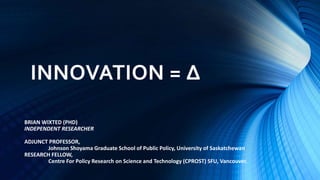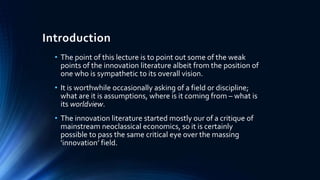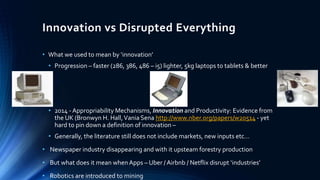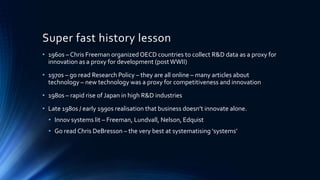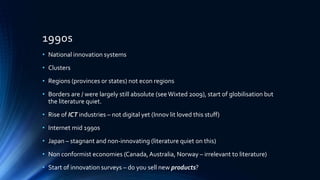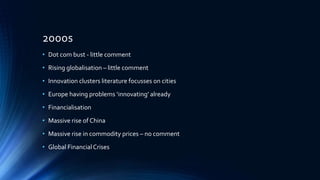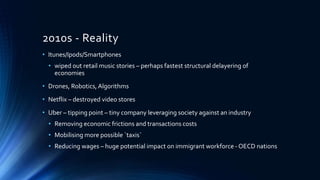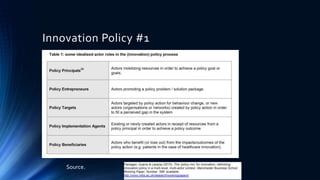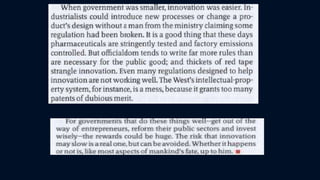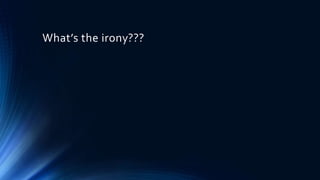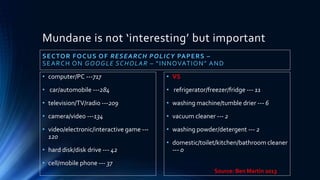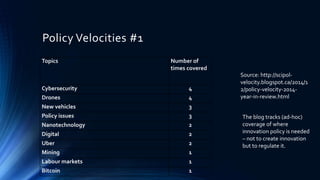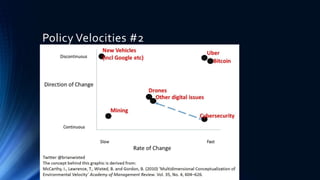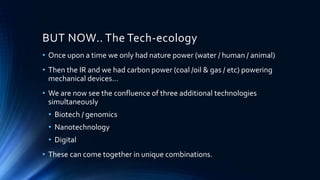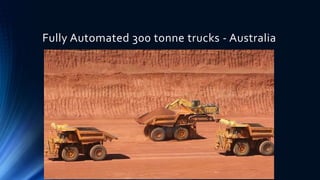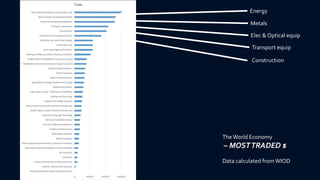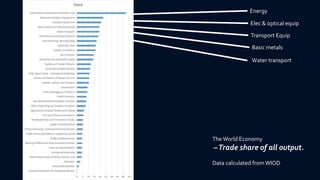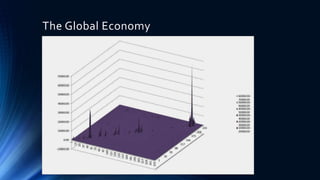INNOVATION = â
- 1. INNOVATION = â BRIAN WIXTED (PHD) INDEPENDENT RESEARCHER ADJUNCT PROFESSOR, Johnson Shoyama Graduate School of Public Policy, University of Saskatchewan RESEARCH FELLOW, Centre For Policy Research on Science and Technology (CPROST) SFU, Vancouver.
- 2. â = ?
- 3. Introduction âĒ The point of this lecture is to point out some of the weak points of the innovation literature albeit from the position of one who is sympathetic to its overall vision. âĒ It is worthwhile occasionally asking of a field or discipline; what are it is assumptions, where is it coming from â what is its worldview. âĒ The innovation literature started mostly our of a critique of mainstream neoclassical economics, so it is certainly possible to pass the same critical eye over the massing âinnovationâ field.
- 4. Innovation vs Disrupted Everything âĒ What we used to mean by âinnovationâ âĒ Progression â faster (286, 386, 486 â i5) lighter, 5kg laptops to tablets & better âĒ âĒ 2014 - Appropriability Mechanisms, Innovation and Productivity: Evidence from the UK (Bronwyn H. Hall,Vania Sena http://www.nber.org/papers/w20514 - yet hard to pin down a definition of innovation â âĒ Generally, the literature still does not include markets, new inputs etcâĶ âĒ Newspaper industry disappearing and with it upsteam forestry production âĒ But what does it mean whenApps â Uber / Airbnb / Netflix disrupt âindustriesâ âĒ Robotics are introduced to mining
- 5. Super fast history lesson âĒ 1960s â Chris Freeman organizedOECD countries to collect R&D data as a proxy for innovation as a proxy for development (postWWII) âĒ 1970s â go read Research Policy â they are all online â many articles about technology â new technology was a proxy for competitiveness and innovation âĒ 1980s â rapid rise of Japan in high R&D industries âĒ Late 1980s / early 1990s realisation that business doesnât innovate alone. âĒ Innov systems lit â Freeman, Lundvall, Nelson, Edquist âĒ Go read Chris DeBresson â the very best at systematising âsystemsâ
- 6. 1990s âĒ National innovation systems âĒ Clusters âĒ Regions (provinces or states) not econ regions âĒ Borders are / were largely still absolute (seeWixted 2009), start of globilisation but the literature quiet. âĒ Rise of ICT industries â not digital yet (Innov lit loved this stuff) âĒ Internet mid 1990s âĒ Japan â stagnant and non-innovating (literature quiet on this) âĒ Non conformist economies (Canada,Australia, Norway â irrelevant to literature) âĒ Start of innovation surveys â do you sell new products?
- 7. 2000s âĒ Dot com bust - little comment âĒ Rising globalisation â little comment âĒ Innovation clusters literature focusses on cities âĒ Europe having problems âinnovatingâ already âĒ Financialisation âĒ Massive rise of China âĒ Massive rise in commodity prices â no comment âĒ Global FinancialCrises
- 8. 2010s - Literature âĒ Entrepreneurship âĒ Policy mixes (whatever that is) âĒ Open innovation âĒ University technology commercialisation âĒ Non innovation based literature
- 9. 2010s - Reality âĒ Itunes/Ipods/Smartphones âĒ wiped out retail music stories â perhaps fastest structural delayering of economies âĒ Drones, Robotics, Algorithms âĒ Netflix â destroyed video stores âĒ Uber â tipping point â tiny company leveraging society against an industry âĒ Removing economic frictions and transactions costs âĒ Mobilising more possible `taxis` âĒ Reducing wages â huge potential impact on immigrant workforce - OECD nations
- 11. Innovation Policy #2 Source: Guy 2012
- 15. The London Sewer System âĒ The London sewers were a public investment. âĒ Some Government innovations have had the biggest impact of allâĶ
- 16. Mundane is not âinterestingâ but important SECTOR FOCUS OF RESEARCH POLICY PAPERS â SEARCH ON GOOGLE SCHOLAR â âINNOVATIONâ AND âĒ computer/PC ---717 âĒ car/automobile ---284 âĒ television/TV/radio ---209 âĒ camera/video ---134 âĒ video/electronic/interactive game --- 120 âĒ hard disk/disk drive --- 42 âĒ cell/mobile phone --- 37 âĒ VS âĒ refrigerator/freezer/fridge --- 11 âĒ washing machine/tumble drier --- 6 âĒ vacuum cleaner --- 2 âĒ washing powder/detergent --- 2 âĒ domestic/toilet/kitchen/bathroom cleaner --- 0 Source: Ben Martin 2013
- 17. Policy Velocities #1 Topics Number of times covered Cybersecurity 4 Drones 4 New vehicles 3 Policy issues 3 Nanotechnology 2 Digital 2 Uber 2 Mining 1 Labour markets 1 Bitcoin 1 Source: http://scipol- velocity.blogspot.ca/2014/1 2/policy-velocity-2014- year-in-review.html The blog tracks (ad-hoc) coverage of where innovation policy is needed â not to create innovation but to regulate it.
- 19. BUT NOW.. The Tech-ecology âĒ Once upon a time we only had nature power (water / human / animal) âĒ Then the IR and we had carbon power (coal /oil & gas / etc) powering mechanical devicesâĶ âĒ We are now see the confluence of three additional technologies simultaneously âĒ Biotech / genomics âĒ Nanotechnology âĒ Digital âĒ These can come together in unique combinations.
- 20. Fully Automated 300 tonne trucks - Australia
- 21. Agriculture sensor network in Australia
- 22. Confluences, contradictions, weirdness Digital Digital mfg New crop mgt Bio mining Bio ? ? ? Nano Mech 3D printing Algorith ms Apps Senors Robots
- 23. How do we measure any of this PRODUCTIVITY âĒ Measures labour per output âĒ 1.Problems measuring this âĒ 2. Labour of 1. âĒ So seriously productivity is really problematic âĒ Count $ âĒ R&D, innovation sales (rubbish numbers) KEEP SCEPTICAL
- 24. The World Economy â total value of activities. Data calculated fromWIOD Business services Construction Real Estate Government Finance industry
- 25. The World Economy â MOSTTRADED $ Data calculated fromWIOD Energy Metals Elec & Optical equip Transport equip Construction
- 26. The World Economy âTrade share of all output. Data calculated fromWIOD Energy Elec & optical equip Transport Equip Basic metals Water transport
- 27. Innovation, Technology or Technium âĒ Innovation is a fairly linear concept â âĒ build a better product and you will be more competitive âĒ Societies & economies need to encourage as much innovation as possible â that will create jobs and wealth. âĒ Maybe yes maybe no â but it is far too simple. âĒ Read Brian Arthurâs â The Nature ofTechnology sometime. âĒ Kevin Kelly talks about the Technium â technology as its own life structure â somewhere perhaps between fungus and mammals. âĒ Not without problems but concept is getting richer â watch him at www.longnow.org
- 29. What is written isnât the sum of what is true âĒ Richard Feynman âĒ A very great deal more truth can become known than can be proven. âĒ We have a habit in writing articles published in scientific journals to make the work as finished as possible, to cover all the tracks, to not worry about the blind alleys or to describe how you had the wrong idea first, and so on. So there isn't any place to publish, in a dignified manner, what you actually did in order to get to do the work. âĒ "The Development of the Space-TimeView of Quantum Electrodynamics," Nobel Lecture (11 December 1965) âĒ For a successful technology, reality must take precedence over public relations, for nature cannot be fooled. http://history.nasa.gov/rogersrep/v2appf.htm

